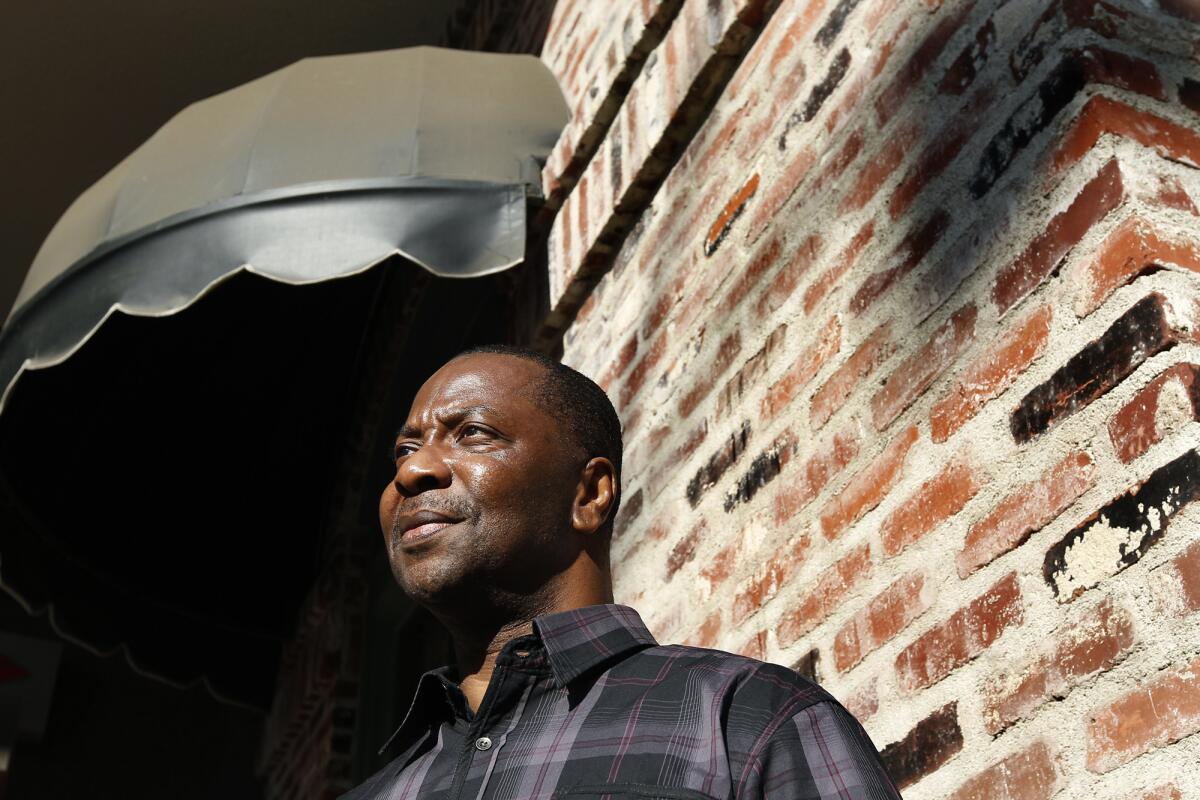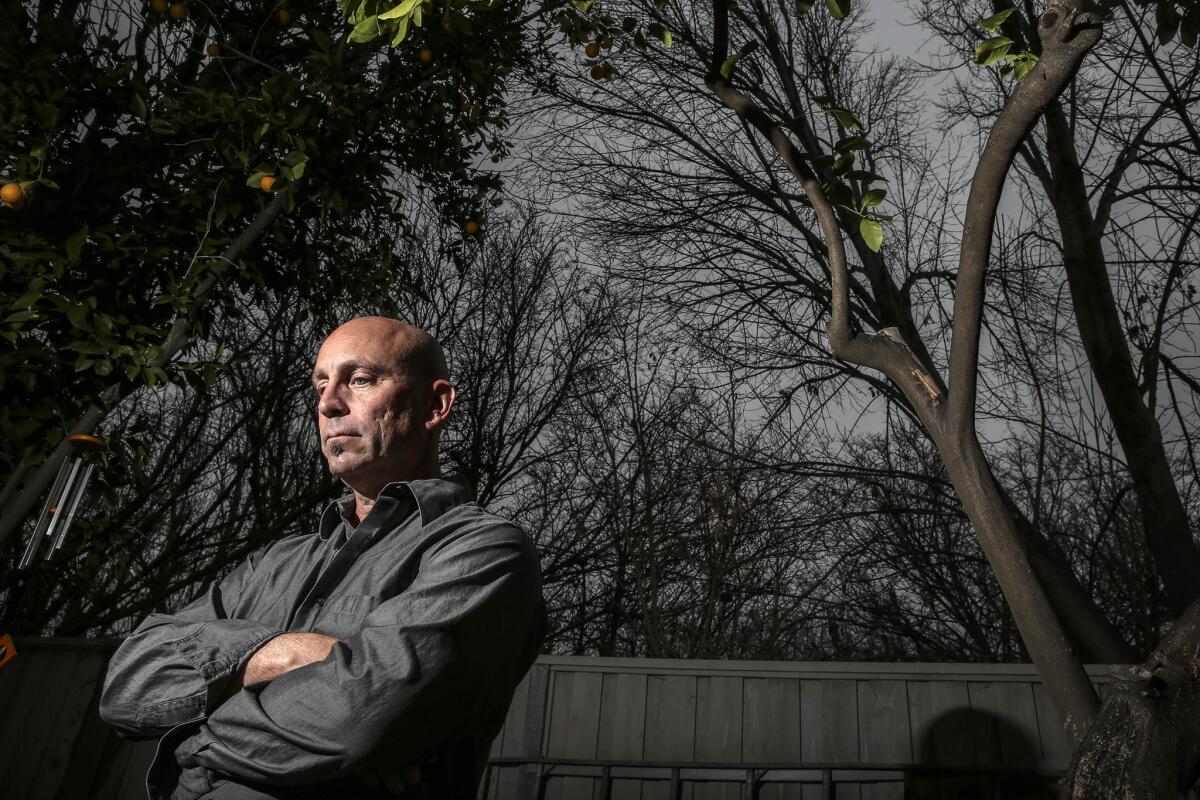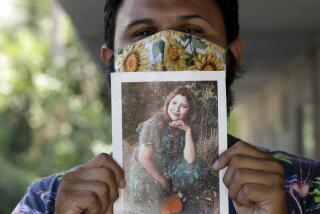L.A. to pay $24 million to two men imprisoned for decades after wrongful murder convictions

Kash Register outside a Los Angeles restaurant in November 2013 after his release from prison.
The Los Angeles City Council agreed Tuesday to pay more than $24 million to settle lawsuits from two men who alleged that investigations by dishonest LAPD detectives led to their wrongful murder convictions and caused them to spend decades behind bars.
Kash Delano Register, who won his freedom in 2013 after lawyers and students from Loyola Law School cast doubt on the testimony of a key prosecution witness, will receive $16.7 million â the largest settlement in an individual civil rights case in the cityâs history, his attorneys said. Bruce Lisker, who was released from prison in 2009 after a Times investigation into his conviction, will get $7.6 million.
Join the conversation on Facebook >>
Though the cases were unrelated, both men contended that detectives ignored evidence of their innocence and fabricated evidence of their guilt.
City lawyers concerned about the police misconduct allegations recommended the settlements, saying in confidential memos to the City Council obtained by The Times that taking the cases to trial could be even more financially devastating.

Bruce Lisker, wrongly convicted of murder, is to receive $7.6 million from Los Angeles. He was in custody for 26 years.
âThis is an extremely dangerous case,â city attorneys wrote of the Lisker case. And Registerâs case was even âmore problematic,â they said.
âTodayâs action helps make amends for the many years these men will never get back, and for lives that will never be the same,â said Rob Wilcox, a spokesman for City Atty. Mike Feuer.
City Councilman Paul Krekorian, who heads the budget committee that weighs settlement payments, said the two cases were the âvery unfortunateâ result of police misconduct in the past, but did not reflect how the department operates today.
âItâs just regrettable that these two individuals spent the better part of their lives in prison as a result of the inadequacy of the investigations that happened back then,â Krekorian said.
Register, who has always maintained his innocence, spent 34 years in custody after being convicted of the 1979 armed robbery and murder of Jack Sasson, 78.
The case against Register was based on eyewitness testimony. No murder weapon was recovered and none of the fingerprints lifted at the West Los Angeles crime scene matched Registerâs. Police seized a pair of his pants that had a speck of blood on them, but the blood type matched both Sassonâs and Registerâs. Registerâs girlfriend testified that he was with her at the time of the shooting.
A key prosecution witness in the case was Brenda Anderson, who told police she heard gunshots and saw Register sprinting away from the scene. She picked him out of a photo lineup, police said. But Andersonâs sisters said they told police that her account wasnât true.
In court papers, Sheila Vanderkam said she had tried to tell a detective that her sister had lied about seeing Register flee. The detective, she said, put a finger to his lips to convey that she should keep quiet. Another sister, Sharon Anderson, also said in court papers that she had told police they had the wrong man, but she too was ignored.
NEWSLETTER: Get the dayâs top headlines from Times Editor Davan Maharaj >>
Brenda Anderson picked Register out of a photo array only after police threatened to prosecute her for credit card forgery and a recent theft, promising to hold off if she followed their instructions and identified someone, Registerâs attorneys alleged.
Decades later, Vanderkam typed Registerâs name into the stateâs Department of Corrections website and discovered he was still imprisoned â a realization that spurred her to find his attorney and launched a fresh examination of his case. Register, now 55, was ultimately freed in November 2013.
LAPD Chief Charlie Beck said the department has âmany, many things in place now that werenât in place then that prevents this kind of thing from happening.â
But Register and his attorneys said Tuesday they hoped his case would spur reforms at the LAPD in the way eyewitnesses are asked to choose a suspect from a photo lineup. Many experts argue that police should ensure that the detective who has a possible suspect in mind is not involved at all or does not see which photo a witness is choosing.
âI canât get these 34 years back, but I hope my case can help make things better for others, through improving the way the police get identifications,â Register said in a statement.
While in prison, Register missed the birth of his daughter and two grandchildren. At one point in his incarceration, another inmate slashed his neck, his attorneys said in his lawsuit. He now works in a warehouse for a large department store, supporting family members.
âAfter almost 37 years, I am more than ready to try to put this all behind me and move on with my life,â Register said.
Lisker, now 50, said he, too, was ready to put his case âin the rearview mirror.â He was convicted of killing his 66-year-old mother, Dorka, and spent 26 years in custody.
âItâs a very happy day. Itâs a vindication and an acknowledgment by the city of Los Angeles at its highest levels that what I have said all along is true, that I am innocent and at 17 I was framed by the LAPD for the murder of my mother,â an emotional Lisker said in a telephone interview after the vote was announced.
âThe toll this ordeal has taken on me and my family is incalculable. The money is nowhere near enough,â Lisker added. âHow can one place a monetary figure on a lifetime of stolen freedom, of crushed aspirations and a shattered reputation, on my motherâs tragic murder going unsolved and neglected for 33 years and counting? There are no words, just as there is no amount that can adequately compensate me for whatâs happened.â
At the time of his motherâs killing, detectives were immediately suspicious of Lisker, a frizzy-haired 17-year-old who had a history of drug abuse and fighting with his mother. Lisker told police he saw her lying in the foyer and broke into the house to help her, but detectives didnât believe him.
The case against him hinged chiefly on four things: blood spatter on the clothes that Lisker was wearing, the testimony of a jailhouse informant, bloody shoe prints that police said placed only Lisker at the scene, and police saying it was impossible for him to see his mother lying on the floor from outside.
A Times investigation in 2005 raised questions about the case against Lisker, showing that the murder investigation was sloppy and incomplete.
Later, at a hearing in federal court challenging Liskerâs conviction, the key elements of the prosecutionâs case were undermined or disproved.
For example, an LAPD analyst and an FBI expert testified that a bloody print found in the bathroom of the Lisker familyâs Sherman Oaks house and attributed to Lisker at trial was not made by his shoes.
As for Lisker being able to see his mother from a window at the back of the home, experiments first performed by Times reporters and then corroborated by expert testimony proved he could have seen his mother as he had asserted. Liskerâs lawyers also alleged that the lead detective ignored evidence of another possible suspect â a friend of Liskerâs.
They also accused the detective of writing a letter to the parole board years after Liskerâs conviction in which he falsely claimed to have recovered additional evidence of his guilt. That letter, city attorneys said in their memo to the council, âon its own, significantly imperils the cityâs chances for a successful verdictâ if the case went to trial.
Since his release from prison, Lisker has married and now resides in Woodland Hills. One of the first things he said he plans to do with the money is pay off credit card debt.
âThis settlement will allow me to survive and to enjoy however many years I have left in me, which hopefully is a very large number,â he said.
Follow @latimesemily for whatâs happening at Los Angeles City Hall
Times staff writer Kate Mather contributed to this report.
ALSO
Firms left out of LAPDâs body camera search decry âpiggybackingâ bid process
In latest case of L.A. jail abuse, trial will focus on alleged beating of handcuffed inmate
Erin Brockovich appeals to Porter Ranch residents as law firms push gas leak suits
More to Read
Sign up for Essential California
The most important California stories and recommendations in your inbox every morning.
You may occasionally receive promotional content from the Los Angeles Times.











